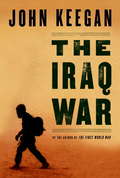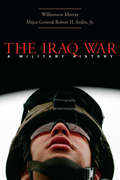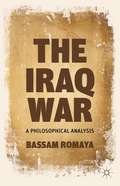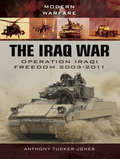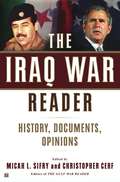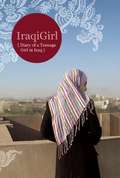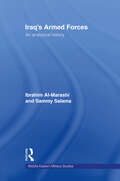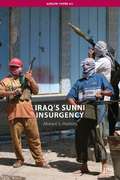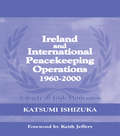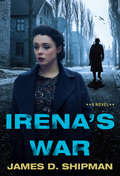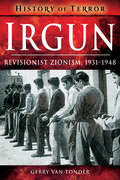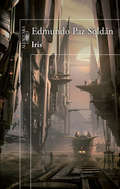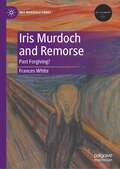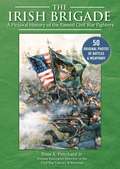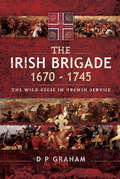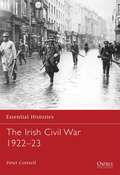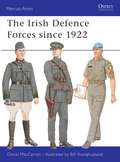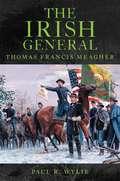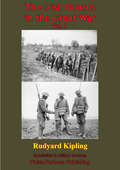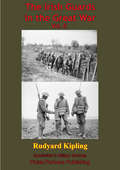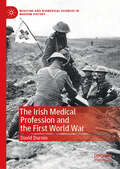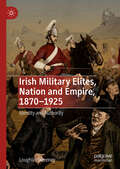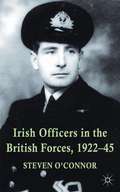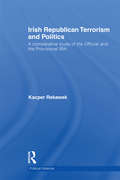- Table View
- List View
The Iraq War
by John KeeganAuthor of the acclaimedThe Face of Battle, and, most recently,Intelligence in War, John Keegan now brings his extraordinary expertise to bear on perhaps the most controversial war of our time. The Iraq War is an urgently needed, up-to-date and informed study of the ongoing conflict. In exclusive interviews with Secretary of Defense Donald Rumsfeld and General Tommy Franks, Keegan has gathered information about the war that adds immeasurably to our grasp of its causes, complications, costs and consequences. He probes the reasons for the invasion and delineates the strategy of the American and British forces in capturing Baghdad; he examines the quick victory over the Republican Guard and the more tenacious and deadly opposition that has taken its place. He then analyzes the intelligence information with which the Bush and Blair administrations convinced their respective governments of the need to go to war, and which has since been strongly challenged in both countries. And he makes clear that despite the uncertainty about weapons of mass destruction, regime change, and the use and misuse of intelligence, the war in Iraq is an undeniably formidable display of American power. The Iraq War is authoritative, timely and vitally important to our understanding of a conflict whose full ramifications are as yet unknown.
The Iraq War: A Military History
by Williamson Murray Robert H. Scales Jr.In this unprecedented account of the intensive air and ground operations in Iraq, two of America's most distinguished military historians bring clarity and depth to the first major war of the new millennium. Reaching beyond the blaring headlines, embedded videophone reports, and daily Centcom briefings, Williamson Murray and Robert Scales analyze events in light of past military experiences, present battleground realities, and future expectations. The Iraq War puts the recent conflict into context. Drawing on their extensive military expertise, the authors assess the opposing aims of the Coalition forces and the Iraqi regime and explain the day-to-day tactical and logistical decisions of infantry and air command, as British and American troops moved into Basra and Baghdad. They simultaneously step back to examine long-running debates within the U. S. Defense Department about the proper uses of military power and probe the strategic implications of those debates for America's buildup to this war. Surveying the immense changes that have occurred in America's armed forces between the Gulf conflicts of 1991 and 2003--changes in doctrine as well as weapons--this volume reveals critical meanings and lessons about the new "American way of war" as it has unfolded in Iraq.
The Iraq War
by Bassam RomayaThis book features a critique of key philosophical doctrines that dominate the Iraq war debate: just war theory, humanitarian intervention, democratic realism, and preventive war doctrine. The author evaluates each and develops a philosophical approach that offers a model for thinking through the philosophical dilemmas introduced by new wars.
The Iraq War: Operation Iraqi Freedom 2003–2011 (Modern Warfare)
by Anthony Tucker-JonesThe Iraq War is a visual record of the American-led Operation Iraqi Freedom of 2003, which resulted in the dramatic overthrow of dictator Saddam Hussein. In a striking sequence of photographs Anthony Tucker-Jones shows how this was achieved by the American and British armed forces in a lightning campaign of just two weeks. But the photographs also show the disastrous aftermath when the swift victory was undermined by the outbreak of the Iraqi insurgency - in the Shia south, in Baghdad and the Sunni Triangle, and in Fallujah where two ferocious battles were fought. The author, who is an expert on the Iraqi armed forces and has written extensively on the Iran-Iraq War and the Gulf War, gives a fascinating insight into the Iraqi army and air force and into the multitude of weapons systems Saddam purchased from around the world. He also looks at the failures on the American and British side - the flaws in the tactics that were used, the poor performance of some of the armoured fighting vehicles and at the reformed Iraqi armed forces who have now taken responsibility for security in the country. The Iraq War is a vivid photographic introduction to a conflict that has only just passed into history.
The Iraq War Reader: History, Documents, Opinions
by Micah L. Sifry Christopher CerfDespite the torrent of coverage devoted to war with Iraq, woefully little attention has been paid to the history of the region, the policies that led to the conflict, and the daunting challenges that will confront America and the Middle East once the immediate crisis has ended. In this collection, Micah L. Sifry and Christopher Cerf, coeditors of the acclaimed Gulf War Reader, have assembled essays and documents that present an eminently readable, up-to-the-moment guide -- from every imaginable perspective -- to the continuing crisis in the Gulf and Middle East. Here, in analysis and commentary from some of the world's leading writers and opinion makers -- and in the words of the key participants themselves -- is the engrossing saga of how oil economics, power politics, dreams of empire, nationalist yearnings, and religious fanaticism -- not to mention naked aggression, betrayal, and tragic miscalculation -- have conspired to bring us to the fateful collision of the West and the Arab world over Iraq. Contributors include: Fouad Ajami, George W. Bush, Richard Butler, John le Carré, Noam Chomsky, Ann Coulter, Thomas Friedman, Al Gore, Seymour Hersh, Christopher Hitchens, Arianna Huffington, Saddam Hussein, Terry Jones, Robert Kagan, Charles Krauthammer, William Kristol, Nicholas Lemann, Kanan Makiya, Kevin Phillips, Kenneth Pollack, Colin Powell, Condoleezza Rice, Arundhati Roy, Edward Said, William Safire, Jonathan Schell, Susan Sontag, George Will.
The Iraq Wars and America's Military Revolution
by Keith L. ShimkoMany saw the United States' decisive victory in Desert Storm (1991) as not only vindication of American defense policy since Vietnam but also confirmation of a revolution in military affairs (RMA). Just as information-age technologies were revolutionizing civilian life, the Gulf War appeared to reflect similarly profound changes in warfare. A debate has raged ever since about a contemporary RMA and its implications for American defense policy. Addressing these issues, The Iraq Wars and America's Military Revolution is a comprehensive study of the Iraq Wars in the context of the RMA debate. Focusing on the creation of a reconnaissance-strike complex and conceptions of parallel or nonlinear warfare, Keith L. Shimko finds a persuasive case for a contemporary RMA while recognizing its limitations as well as promise. The RMA's implications for American defense policy are more ambiguous because the military lessons of the Iraq Wars need be placed in the context of judgments about national interests and predictions of future strategic environments.
Iraqigirl: Diary of a Teenage Girl in Iraq
by Elizabeth Wrigley-FieldHadiya began her blog just under a year and a half into the U.S. occupation of Iraq. She writes from Mosul, a diverse city with many Sunni Muslims, like Hadiya's family. Mosul has become one center of resistance to the occupation. Hadiya's name is not really Hadiya. We have used pseudonyms for every Iraqi in this story because each of their lives could be in danger if they were identified. But Hadiya is a real teenager in Mosul, and this is her story.
Iraq's Armed Forces: An Analytical History (Middle Eastern Military Studies)
by Ibrahim Al-Marashi Sammy SalamaThis book provides the first comprehensive study of the evolution of the Iraqi military from the British mandate era to post-Baathist Iraq. Ethnic and sectarian turmoil is endemic to Iraq, and its armed forces have been intertwined with its political affairs since their creation. This study illustrates how the relationship between the military and
Iraq’s Sunni Insurgency: Iraq's Sunni Insurgency (Adelphi series)
by Ahmed S. HashimFrom 2003 to 2008, the Sunni Arab insurgency in Iraq posed a key challenge to political stability in the country and to Coalition objectives there. This paper explains the onset, composition and evolution of this insurgency. It begins by addressing both its immediate and deeper sociopolitical origins, and goes on to examine the multiple ideological strands within the insurgency and their often conflicting methods and goals. Despite organisational incoherence due to the existence of a large number of competing groups, the insurgency in Iraq sustained a particularly high tempo of operations between 2004 and 2006, causing considerable military and civilian casualties. Some insurgent groups focused on attempting to foment civil war between two of Iraq’s major communities, the Sunni and Shia Arabs and, by late 2006, they had come close to unravelling Iraq and presenting the Coalition with a major defeat. The adoption of a new approach by the US in 2007 helped reduce the level of violence in Iraq. In addition, deep fissures within the insurgency itself, between those fighting for more practical, immediate goals and the transnational Islamists and their local allies fighting for wider-reaching goals – including the promotion of sectarian strife – contributed to the insurgency’s diminution. It remains to be seen whether there will be a widespread recognition among Sunni Iraqis of the need to work with the Coalition to facilitate their community’s reintegration into the new Iraqi body politic.
Ireland and International Peacekeeping Operations 1960-2000
by Katsumi IshizukaThe Republic of Ireland has won its status as a leading contributor to international peacekeeping operations, which has been its key 'foreign policy' since the 1960s. But why is Ireland so keen to be involved? This new book asks and answers this and other key questions about Ireland's close involvement with the EU. It cannot simply be for charitable reasons, so is it because it is a neutral state or because it is a middle power? Overall, is Ireland's peacekeeping policy based on realism and liberalism? The characteristics of peacekeeping operations have changed significantly, especially since the end of the Cold War. Can Ireland survive as a traditional peacekeeping contributor or does it have to change its peacekeeping policy radically? And will it be able to maintain its distance from NATO and the EU in terms of peacekeeping operations? This title attempts to answer all of these questions, drawing on a wide range of resources from literature, Irish and UN documents, to newspapers and interviews.
Irena's War
by James D. Shipman&“Shipman dazzles in this historical tour-de-force based on the real-life story of WWII Polish resistance fighter Irena Sendler . . . spellbinding." —Publishers Weekly (Starred Review)Based on the gripping true story of an unlikely Polish resistance fighter who helped save thousands of Jewish children from the Warsaw ghetto during World War II, bestselling author James D. Shipman&’s Irena&’s War is a heart-pounding novel of courage in action, helmed by an extraordinary and unforgettable protagonist. September 1939: The conquering Nazis swarm through Warsaw as social worker Irena Sendler watches in dread from her apartment window. Already, the city&’s poor go hungry. Irena wonders how she will continue to deliver food and supplies to those who need it most, including the forbidden Jews. The answer comes unexpectedly. Dragged from her home in the night, Irena is brought before a Gestapo agent, Klaus Rein, who offers her a position running the city&’s soup kitchens, all to maintain the illusion of order. Though loath to be working under the Germans, Irena learns there are ways to defy her new employer—including forging documents so that Jewish families receive food intended for Aryans. As Irena grows bolder, her interactions with Klaus become more fraught and perilous. Klaus is unable to prove his suspicions against Irena—yet. But once Warsaw&’s half-million Jews are confined to the ghetto, awaiting slow starvation or the death camps, Irena realizes that providing food is no longer enough. Recruited by the underground Polish resistance organization Zegota, she carries out an audacious scheme to rescue Jewish children. One by one, they are smuggled out in baskets and garbage carts, or led through dank sewers to safety—every success raising Klaus&’s ire. Determined to quell the uprising, he draws Irena into a cat-and-mouse game that will test her in every way—and where the slightest misstep could mean not just her own death, but the slaughter of those innocents she is so desperate to save.
Irgun: Revisionist Zionism, 1931–1948 (History of Terror)
by Gerry van TonderA history of the controversial underground group that employed political violence in its quest to create an independent Israel. Includes photos. In October 1944, the US Office of Strategic Services described the Irgun Tsvai Leumi—National Military Organization—as &“an underground, quasi-military organization with headquarters in Palestine . . . fanatical Zionists who wish to convert Palestine and Transjordan into an independent Jewish state [and] advocate the use of force both against the Arabs and the British to achieve this maximal political goal.&” This book delves into the origins and history of Irgun. In 1925, Ze&’ev Jabotinsky founded the Revisionist Zionism organization, whose secular, right-wing ideology would lead to the formation of the Irgun and, ultimately, of the Likud Party. Commencing operations in the British Mandate of Palestine in 1931, Irgun adopted a mainly guarding role, while facilitating the ongoing immigration of Jews into Palestine. In 1936, Irgun guerrillas started attacking Arab targets. The British White Paper of 1939 rejected the establishment of a Jewish nation, and as a direct consequence, Irgun guerrillas started targeting the British. The authorities executed captured Irgun operatives found guilty of terrorism, while deporting hundreds to internment camps overseas. As details of Jewish genocide—the Holocaust—emerged, Irgun declared war on the British in Palestine. Acts of infrastructural sabotage gave way to the bombing of buildings and police stations, the worst being the bombing of the King David Hotel in Jerusalem—the hub of British operations and administration—in July 1946, killing ninety-one. Freedom fighters or terrorists, Irgun was only dissolved when the independent Jewish state of Israel was born on May 14, 1948. This is their story.
Iris
by Edmundo Paz SoldánUna distopía arrolladora e hipnótica sobre la forma en que se reinventan los individuos en tiempos de guerra, una fábula desoladora sobre los excesos del poder y, al final, un relato esperanzador sobre la lucha por la libertad. <P><P>En un futuro no muy lejano, en una región tóxica llamada Iris, se encuentra el Perímetro, territorio de las fuerzas colonizadoras. En el Perímetro viven Xavier, un soldado que debe lidiar con una traumática herida de combate, y el capitán Reynolds y su unidad, que, cansados ante las victorias de los irisinos liderados por Orlewen, deciden emprender su guerra particular. <P><P>El Perímetro es también el hogar de Yaz, una enfermera que se encuentra allí en busca del jün, planta sagrada que ofrece visiones psicotrópicas y trascendencia. Pero el combate no solo se libra en la capital. La lucha se traslada a Malhado, un valle florido donde -cuentan las leyendas irisinas- vive el temible Malacosa, y a Megara, centro dela explotación minera y de los mitos en torno a Xlött, el dios demoníaco en nombre del cual se inicia la batalla final por la independencia de Iris. <P><P>Iris es una novela de gran originalidad, un paso adelante en la trayectoria de Edmundo Paz Soldán. Desde la primera página, transporta a los lectores a un mundo tenebroso y los somete a su lógica, a su delirio, a su violencia y angustia.
Iris Murdoch and Remorse: Past Forgiving? (Iris Murdoch Today)
by Frances WhiteThis exploration of the crucially important role played by remorse in Iris Murdoch’s philosophical, theological, and political thinking identifies it as a critical concept in her moral psychology and a recurrent theme in her art. Through engagement with Simone Weil, current theories of remorse, trauma theory and Holocaust studies, it offers fresh perspectives on Murdoch’s fiction – particularly the late novels, her radio play The One Alone, and her monograph Heidegger.
The Irish Brigade: A Pictorial History of the Famed Civil War Fighters
by Russ A. Pritchard Jr.A Full-Color History for Civil War Enthusiasts, History Buffs, and Anyone Interested in the Saga of the Irish in America! The Union’s Irish Brigade, the Civil War’s most famous fighting outfit, built an unusual reputation for dash and gallantry having fought throughout the war, from First Bull Run in 1861 to the Confederate surrender and Appomattox Court House in 1865. Here is the gripping true story, replete with stunning full-color illustrations, of all Irish regiments from Pennsylvania, Massachusetts, and New York serving under the direction of the Brigade’s most famous commander, General Thomas Francis Meagher. This meticulously researched text features complete and detailed accounts of the Brigade’s battles and skirmishes, from Bull Run to Yorktown to Peach Orchard to Malvern Hill to Antietam to Petersburg—to name a few. This powerful, authoritative volume captures the heart and tireless effort of the heroic men who rescued the Union from defeat time and time again—enthralling reading with authentic accompanying illustrations that will fascinate everyone from the biggest history buffs to the occasional layman interested in the history of Irish-Americans or the Civil War.
The Irish Brigade, 1670–1745: The Wild Geese in French Service
by D. P. Graham&“Highly Recommended . . . an absorbing account of a military formation that became an elite force within the French Army.&” —Firetrench Irish troops had fought for Louis XIV in the 1670s, under Irish officers who had little choice but to fight in foreign service, with the blessing of Charles II. With the accession of James II, and the religious politics of who might earn the English crown, they became embroiled in the Jacobite succession crisis, fighting in Ireland, then sent to France under Lord Mountcashel in 1689. With the fall of Limerick in 1691, Patrick Sarsfield led the second &“flight&” of &“Wild Geese&” to the continent, to fight in a war for the French, against the Grand Alliance of Europe, in the vain hope that their loyalty might warrant French support in a return to Ireland under a Jacobite king. From the Nine Years War, through the War of the Spanish Succession, and beyond, their descendants would be present at Fontenoy, Culloden and in the Americas, forever destined to fight for a cause and land which had changed beyond recognition. D.P. Graham explains the origins of the brigade and its regiments, the personalities who led them and formed their reputation, and the circumstances of their final dissolution in the aftermath of French Revolution. &“An excellent study of the events that led up to the creation of the Wild Geese, and in particular the brutal war in Ireland, a conflict that still has an impact in the present day.&” —History of War
The Irish Civil War 1922-23
by Peter CottrellIn a sequel to his successful best-selling "ESS 65 The Anglo-Irish War," Peter Cottrell explores the devastating conflict that tore Ireland apart, shortly after 'peace' had been declared. He focuses on the short but bloody battles that witnessed more deaths than the preceding years of the War of Independence. Examining the many factions that played a part in the fighting, and more often in the terror and counter-terror operations, Cottrell highlights the contrasting styles of leadership and the conduct of combat operations by the IRA and the National Army. He uses detailed tactical maps to explain the tactics that ranged from urban warfare and street-fighting to the final siege of Limerick city. A bitter sequence of attack and reprisal, the Irish Civil War was a complex social and political battle to change the nature of government and politics in Ireland. This book primarily discusses the military operations, but also places these in the wider context of the personalities involved, including Liam Lynch and Michael Collins. It also assesses the impact of the war on civilian life, and its influence on the politics of Ireland at national and international levels thereafter. This is not only the story of one country, but also of the relationships between Ireland and Britain, and Ireland and America, which have had a profound impact on modern politics for decades.
The Irish Defence Forces since 1922
by Bill Younghusband Donal MaccarronBorn in the Civil War of 1922-23, the army of the Republic of Ireland occupied a sensitive place in the national culture for many years. In World War II (1939-1945), it faced the challenge of maintaining Ireland's integrity as neutral. Post-war, it found a new role in 1960, providing troops for the United Nations intervention in the war-torn Congo; and since then has supported UN missions in the Middle East and elsewhere. More recently the border with troubled Ulster has obliged the Republic to invest in reform and modernisation. Ireland's freedom to seek examples and equipment worldwide has created an interesting progression of uniforms, illustrated in this study of Ireland's forces over 80 years.
The Irish General: Thomas Francis Meagher
by Paul R. WylieIrish patriot, Civil War general, frontier governor--Thomas Francis Meagher played key roles in three major historical arenas. Today he is hailed as a hero by some, condemned as a drunkard by others. Paul R. Wylie now offers a definitive biography of this nineteenth-century figure who has long remained an enigma. The Irish General first recalls Meagher's life from his boyhood and leadership of Young Ireland in the revolution of 1848, to his exile in Tasmania and escape to New York, where he found fame as an orator and as editor of the Irish News. He served in the Civil War--viewing the Union Army as training for a future Irish revolutionary force--and rose to the rank of brigadier general leading the famous Irish Brigade. Wylie traces Meagher's military career in detail through the Seven Days battles, Antietam, Fredericksburg, and Chancellorsville. Wylie then recounts Meagher's final years as acting governor of Montana Territory, sorting historical truth from false claims made against him regarding the militia he formed to combat attacking American Indians, and plumbing the mystery surrounding his death. Even as Meagher is lauded in most Irish histories, his statue in front of Montana's capitol is viewed by some with contempt. The Irish General brings this multi-talented but seriously flawed individual to life, offering a balanced picture of the man and a captivating reading experience.
The Irish Guards In The Great War – Vol. I. [Illustrated Edition]
by Rudyard KiplingA Fantastic Regimental History of an Illustrious regiment, awarded two coveted stars by the renowned military historian and Times War Correspondent Cyril Falls:"One could be assured that when Mr Kipling turned his hand to a regimental history the result would be very different to the ordinary. The particular invention wherewith he has enriched this book is a sort of chorus--the comment of the private soldier upon the events narrated, which is witty and effective. Mr Kipling has also brought to bear his magic upon that most matter-of-fact of records, the battalion war diary, and has made it live. *** he has composed a noble tribute to the great regiment in the ranks of which he lost his son."-- Cyril Falls, War Books, London 1930.Illustrated with sumptuously detailed maps.
The Irish Guards In The Great War – Vol. II. [Illustrated Edition]
by Rudyard KiplingA Fantastic Regimental History of an Illustrious regiment, awarded two coveted stars by the renowned military historian and Times War Correspondent Cyril Falls:"One could be assured that when Mr Kipling turned his hand to a regimental history the result would be very different to the ordinary. The particular invention wherewith he has enriched this book is a sort of chorus--the comment of the private soldier upon the events narrated, which is witty and effective. Mr Kipling has also brought to bear his magic upon that most matter-of-fact of records, the battalion war diary, and has made it live. *** he has composed a noble tribute to the great regiment in the ranks of which he lost his son."-- Cyril Falls, War Books, London 1930.Illustrated with sumptuously detailed maps.
The Irish Medical Profession and the First World War (Medicine and Biomedical Sciences in Modern History)
by David DurninThis book examines the role of the Irish medical profession in the First World War. It assesses the extent of its involvement in the conflict while also interrogating the effect of global war on the development of Ireland’s domestic medical infrastructure, especially its hospital network. The study explores the factors that encouraged Ireland’s medical personnel to join the British Army medical services and uncovers how Irish hospital governors, in the face of increasing staff shortages and economic inflation, ensured that Ireland’s voluntary hospital network survived the war. It also considers how Ireland’s wartime doctors reintegrated into an Irish society that had experienced a profound shift in political opinion towards their involvement in the conflict and subsequently became embroiled in its own Civil War. In doing so, this book provides the first comprehensive study of the effect of the First World War on the medical profession in Ireland.
Irish Military Elites, Nation and Empire, 1870–1925: Identity and Authority
by Loughlin SweeneyThis book is a social history of Irish officers in the British army in the final half-century of Crown rule in Ireland. Drawing on the accounts of hundreds of officers, it charts the role of military elites in Irish society, and the building tensions between their dual identities as imperial officers and Irishmen, through land agitation, the home rule struggle, the First World War, the War of Independence, and the partition of Ireland. What emerges is an account of the deeply interwoven connections between Ireland and the British army, casting officers as social elites who played a pivotal role in Irish society, and examining the curious continuities of this connection even when officers’ moral authority was shattered by war, revolution, independence, and a divided nation.
Irish Officers in the British Forces, 1922–45
by Steven O’ConnorIrish Officers in the British forces, 1922-45 looks at the reasons why young Irish people took the king's commission, including the family tradition, the school influence and the employment motive. It explores their subsequent experiences in the forces and the responses in independent Ireland to the continuation of this British military connection.
Irish Republican Terrorism and Politics: A Comparative Study of the Official and the Provisional IRA (Political Violence)
by Kacper RekawekThis book examines the post-ceasefire evolutions and histories of the main Irish republican terrorist factions, and the interconnected character of politics and militarism within them. Offering the first comparative study of the two leading Irish republican terrorist movements the Official IRA and the Provisional IRA (PIRA), this book presents the lesser-known Officials’ political-military evolution and analyses whether they could have been role models for the Provisionals. Not only does it compare the terrorism and the politics of the Officials and Provisionals in the aftermath of their seminal ceasefires of 1972 and 1994, it also presents the Irish republican history in a new light and brings to the fore the understudied and disregarded Officials who called their seminal ceasefire twenty-two years before their rivals in 1972. In doing this, the work discusses whether the PIRA might have learned lessons from the bitter and ultimately unsuccessful experience of the Officials. This book goes beyond traditional interpretations of the rivalry and competition between the two factions with the Officials usually seen as non-violent but unsuccessful and the Provisionals less politically inclined and mostly concerned with their armed struggle. Simultaneously, it dispels the myth of the alleged Provisional republican copying of their Official republican counterparts who seemed ready for a political compromise in Northern Ireland more than twenty years before the Good Friday Agreement of 1998. Finally, it comprehensively compares the Officials and the Provisionals within the identified key areas and assesses the two factions’ differences and similarities. . This book will be of much interest to students of Irish politics, terrorism studies, security studies and politics in general.
